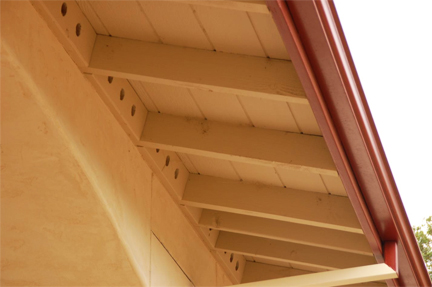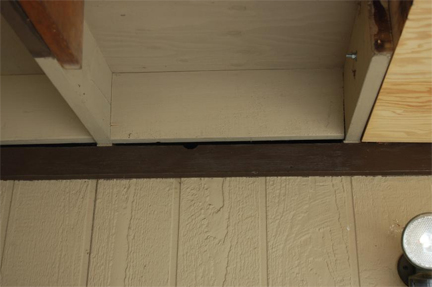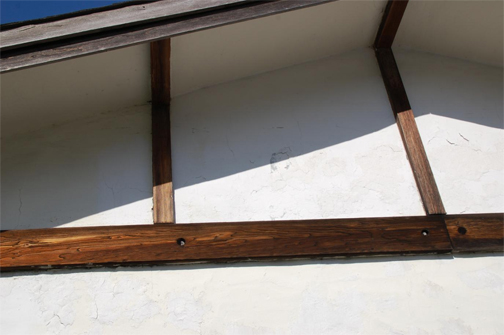Eaves vulnerabilities

The eave overhang protects your home from rain and sun. Depending on design, it also can allow embers to enter through under-eave attic vents. With open-eave construction, gaps between the rafter tails and the blocking can be vulnerable to ember entry. Soffits (boxed-in eaves) are more robust to embers.
In terms of fire exposure (embers or flames), a narrow overhang is arguably better. However, in this case the gutters could expose the attic directly to flame contact if ignited. Also, you should consider other exposures your home will face. For example, a fence attached to the house or vegetation close to exterior walls would directly expose the eave and edge of the roof to flame contact, regardless of eave design.
Currently, vents cannot be installed in an eave or soffit area unless they can resist flames and embers (more information can be found in the vent section).
How can you protect your eaves?
Because of the variety of eaves and configurations, these guidelines are generic, but should give you an idea on how to improve the fire resistance of your eave:
- Does your overhang have places where small animals or debris accumulate? Those could be potential spots for ignition, consider keeping your under-eave clean, especially if it’s an open-eave
- Remove combustible materials (e.g. attached fence) and vegetation next to the exterior wall that could cause flame impingement to your eave
- With open-eave construction, inspect eaves for gaps around rafter roof tails and blocking. Plug or caulk gaps. If possible, enclose the eave.
Some examples are discussed in the table below.

|
Open eave. Under the overhang, the vents are exposed to embers. An ignition-resistant coating could be applied to the under-eave. Fire-resistant vents should be installed under the overhang. |

|
Closed eave. In comparison to open eaves, closed eaves are more fire-resistant. Under-eave vents, however, could still expose the attic. |

|
Open eave, joist bay. This picture shows one joist bay in a roof framing system. Note the gap between the bottom of the 2x blocking member and the top of the exterior wall. This gap makes the area more vulnerable to embers and flames and should be filled. |

|
Coated under-eave. The overhang in this example has stucco wrapped around and under the eave to increase fire resistance. |
California regulations
The main purpose of the eave protection requirement is to prevent fires from reaching the attic. Eaves must meet either of the following requirements in order to comply with Chapter 7A:
- meet the requirement of the standard test SFM 12-7A-3
- shall be protected by ignition-resistant material or non-combustible on the exposed underside
Due to the differences between closed and open eave designs, the details of complying will vary depending on the construction technique.
Closed eave: If the soffit material is rated as non-combustible (for example, three-coat stucco, or a fiber cement soffit material) or ignition resistant (for example, exterior rated fire-retardant-treated plywood), then the design would comply with the provisions of Chapter 7A. If you want to use untreated plywood, or wood tongue-and-groove material as the soffit material, then this construction would have to be tested to SFM 12-7A-3. The material and design being proposed for use must be approved and certified by an accredited fire testing laboratory if they haven't been tested.
Open eave: A generic assembly could consist of 2x rafter tails, ACX plywood sheathing, and 2x4 or 2x6 blocking between the rafter tails. This assembly will have to be tested to SFM 12-7A-3 and pass. Since this assembly has been rated as fire resistant in the building code, there have been discussions as to whether this assembly should be tested to SFM Standard 12-7A-3. The California Building Standards Commission is currently considering language that would clarify this issue. If exterior rated fire retardant products were used in the assembly (plywood sheathing, 2x rafter tails and blocking), the assembly would comply because ignition-resistant materials were used. If non-combustible materials (fiber cement panel, stucco) were used as the sheathing it could also comply.
Products and assemblies that have complied with Chapter 7A can be found in the WUI Product Handbook. Since “ignition resistant” and “non-combustible” are performance-based characteristics (i.e., there is a standard test to show compliance), these materials are included in the Handbook.
Check out these additional wildfire preparedness resources from UC ANR Fire Network Members and our colleagues!
Eaves
- Quarles et al, Vulnerability of the eave to direct flame contact and radiant exposures, Fire and Materials conference, 2011
- Manzello et al., Exposing siding treatments, walls fitted with eaves, and glazing assemblies to fire brand showers, Fire Safety J., 2012
Home Hardening